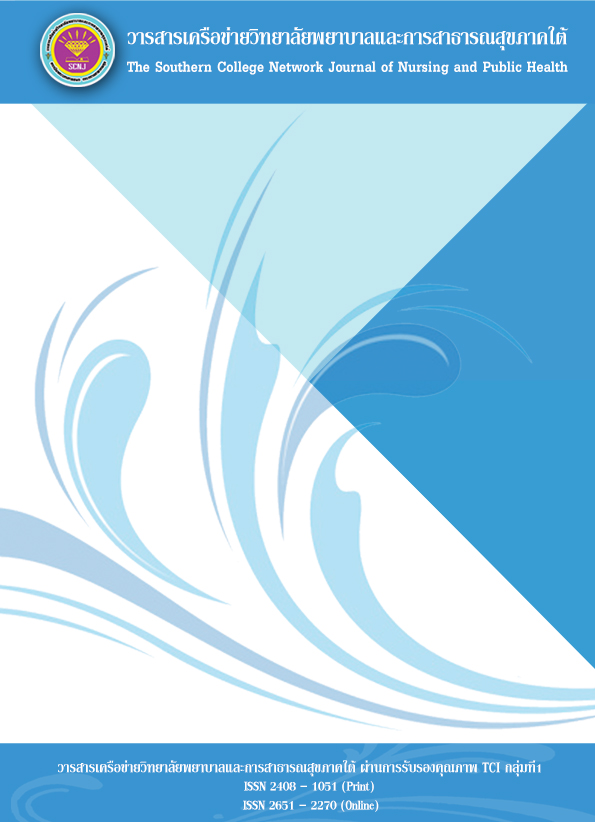ประสิทธิผลของแนวปฏิบัติทางการพยาบาลการวางแผนจำหน่ายต่อคุณภาพชีวิต ของผู้ป่วยสูงอายุโรคหลอดเลือดสมอง
คำสำคัญ:
ผู้สูงอายุโรคหลอดเลือดสมอง, แนวปฏิบัติทางการพยาบาลการวางแผนจำหน่าย, คุณภาพชีวิตบทคัดย่อ
การวิจัยแบบกึ่งทดลองนี้มีวัตถุประสงค์เพื่อศึกษาประสิทธิผลของแนวปฏิบัติทางการพยาบาลการวางแผนจำหน่ายต่อคุณภาพชีวิตของผู้ป่วยสูงอายุโรคหลอดเลือดสมอง กลุ่มตัวอย่างเป็นผู้ป่วยสูงอายุโรคหลอดเลือดสมอง จำนวน 30 ราย และสุ่มเข้ากลุ่มควบคุม และกลุ่มทดลองกลุ่มละ 15 ราย โดยกลุ่มควบคุมได้รับการพยาบาลตามแผนจำหน่ายปกติส่วนกลุ่มทดลองได้รับการดูแลตามแนวปฏิบัติทางการพยาบาลการวางแผนจำหน่ายเป็นรายบุคคล จำนวน 8 สัปดาห์ เครื่องมือที่ใช้ในการวิจัยประกอบด้วยแบบสัมภาษณ์ข้อมูลส่วนบุคคล แบบประเมินคุณภาพชีวิต (SSQOL) ที่มีค่าความเชื่อมั่นสัมประสิทธิ์แอลฟาของครอนบาคเท่ากับ .96 คู่มือแนวปฏิบัติทางการพยาบาลการวางแผนจำหน่ายผู้ป่วยสูงอายุโรคหลอดเลือดสมอง และคู่มือการปฏิบัติตัวและการดูแลผู้ป่วยสูงอายุโรคหลอดเลือดสมอง มีค่าดัชนีความตรงตามเนื้อหาเท่ากับ 1 ทั้งสองชุด วิเคราะห์ข้อมูลด้วยสถิติการแจกแจงความถี่ ร้อยละ ค่าเฉลี่ยส่วนเบี่ยงเบนมาตรฐาน และสถิติทดสอบค่าที ผลการวิจัยพบว่า
หลังการทดลองผู้ป่วยสูงอายุโรคหลอดเลือดสมองกลุ่มทดลอง มีคะแนนเฉลี่ยคุณภาพชีวิตสูงกว่าก่อนการทดลองอย่างมีนัยสำคัญทางสถิติ (t14=14.50, p<.001) และผู้ป่วยสูงอายุโรคหลอดเลือดสมองกลุ่มทดลองมีคะแนนเฉลี่ยคุณภาพชีวิตสูงกว่ากลุ่มควบคุม (t28=3.63, p<.001)
ผลการวิจัยมีข้อเสนอแนะว่า พยาบาลควรนำแนวปฏิบัติทางการพยาบาลการวางแผนจำหน่ายนี้ไปใช้กับผู้ป่วยสูงอายุโรคหลอดเลือดสมองเพื่อเพิ่มคุณภาพชีวิตของผู้ป่วยกลุ่มนี้
เอกสารอ้างอิง
Baramee, J. (2008) Statistics for Health Research and Data Analysis with the SPSS Program. Chonburi: Si Silpakarn. (in Thai)
Birtane, M., & Tastekin, N. (2010). Quality of Life after Stroke. Medical Journal of Trakya University, 27(1), 63-68. (in Thai)
Burns, N. & Grove, S. K. (2005). The Practice of Nursing Research: Conduct, Critique, and Utilization. (5thed). St. Louis, Missouri: Elsevier Saunders.
Chueluecha, C. (2012). Rehabilitation in Stroke. Thaamsat Medical Journal, 12(1), 97-111. (in Thai)
Goma, S. H., Mahran, A. A., Hakeim, D. G., & Ghandour, A. M. (2016). Multicenter Assessment of Health-Related Quality of Life (HRQOL) Among Stroke Survivors. Retrieved November 12, 2016, from http://www.jneuro.com/neurology-neuroscience/multicenter-assessment- of-healthrelated-quality-of-life-hrqol-among-stroke-survivor.pdf
Jackson, M. F. (1994). Discharge Planning: Issues and Challenges for Gerontological Nursing: A Critique of the Literature. Journal of Advanced Nursing, 19(3), 492-502.
Kliangda, R. (2009). Experiences of Headache, Management Strategies and Health-Related Quality of Lift in Patients with Mild Traumatic Brain Injury. Master of Nursing Science Thesis, Adult nursing, Graduate School, Mahidol University. (in Thai)
Mierlo, M. L., Heugten, C. M., Post, M. W., Hajos, T. R., Kappelle, L. J., & Visser-Meity, J. M. (2016). Quality of Lift During the First Two Years Post Stroke: The Restore 4 Stroke Cohort study. Retrieved November 27, 2017, from http:// www.karger.com/Article/Pdf/ 441197
National Health and Medical Research Council [NHMRC]. (1999). A Guide to the Development, Implementation and Evaluation of Clinical Practice Guideline. Retrieved July 10, 2012 form http://www.health.qld.gov.au/cpcre/pdf/nhmrc_clinprgde.pdf
Petchroung, N., Priyatruk, P., & Thongkeang, V. (2013). The Study of Continuing Care for Patients with Cerebrovascular Disease in Primary Care Unit. Journal of The Royal Thai Army Nurses, 14(1), 25-34.
Porka, P. (2014). Development of Clinical Practice Guidelines for Elderly Stroke Rehabilitation Care, Chiangmai Ram Hospital. Master of Nursing Science Thesis, Gerontological Nursing, Graduate School, Chiang Mai University. (in Thai)
Pirani, S. S. (2008). Preventing Delay in the Patient Discharge Process: an Emphasis on the Nursing Role. Canadian Journal of Nursing Informatics, 3(4), 28-51.
Rachpukdee, S., Howteerakul, N., Suwannapong, N., & Tang-aroonsin, S. (2013). Quality of Life of Stroke Survivors: A 3-Mouth Follow-up Study. Journal of stroke and Cerebrovascular Disease, 22(7), 70-78.
Srikhamwiang, B., Aroonsang, P. & Phanphruk, W. (2011). Factors Affecting Functional Status of Hospitalized Older Persons. Journal of Nursing Science & Health, 34(2), 42-51.
Wauters, Y., Oupra, R. & Tanasuwan, P. (2016). Development of a Teaching Model for Prevention of Stroke among People at Risk in Northern Thai Community. The Southern College Network Journal of Nursing and Public Health, 3(2): 100-116. (in Thai)
Williams, L. S., Weinberger, M., Harris, L. E., Clark, D. O., & Biller, J. (1999). Development of A Stroke-Specific Quality of Life Scale. Stroke, 30(7) 1362-1369.
Wongsilarat, T. (2016). Effects of Using the Stroke Fast Tract Program on Ability to Screening and Referral Patient, and Satisfaction among Nurses in Emergency Department, Muang Songkhla Hospital. The Southern College Network Journal of Nursing and Public Health, 3(2), 149-164. (in Thai)
World Stroke Organization. (2016). World Stroke day. Retrieved November 3, 2016 from http://www.worldstrokecampaign.org/get-involved/world-stroke-day.html
ดาวน์โหลด
เผยแพร่แล้ว
ฉบับ
ประเภทบทความ
สัญญาอนุญาต
1. บทความหรือข้อคิดเห็นใด ๆ ที่ปรากฏในวารสารเครือข่าย วิทยาลัยพยาบาลและการสาธารณสุขภาคใต้ ที่เป็นวรรณกรรมของผู้เขียน บรรณาธิการหรือเครือข่ายวิทยาลัยพยาบาลและวิทยาลัยการสาธารณสุขภาคใต้ ไม่จำเป็นต้องเห็นด้วย
2. บทความที่ได้รับการตีพิมพ์ถือเป็นลิขสิทธิ์ของ วารสารเครือข่ายวิทยาลัยพยาบาลและการสาธารณสุขภาคใต้








